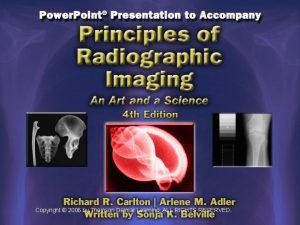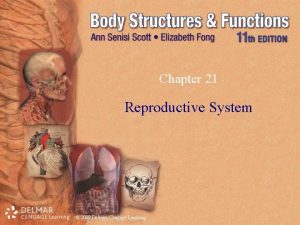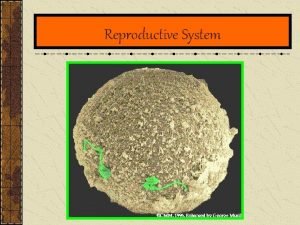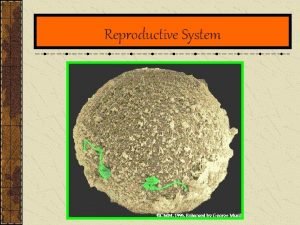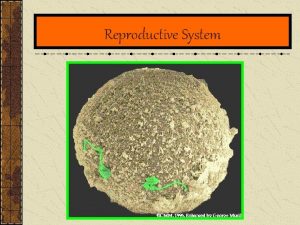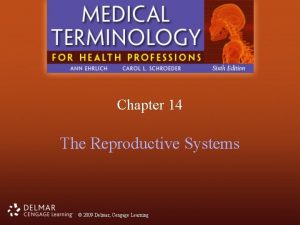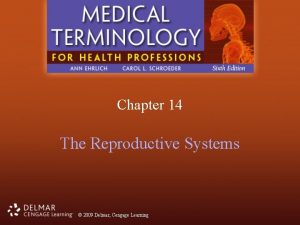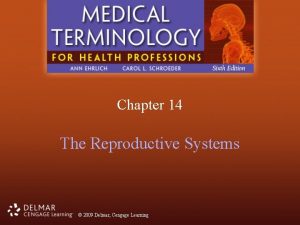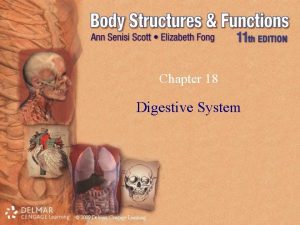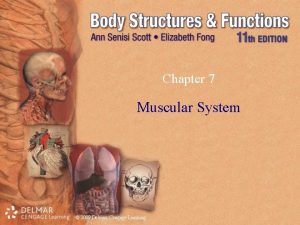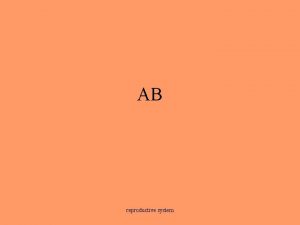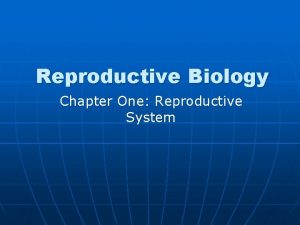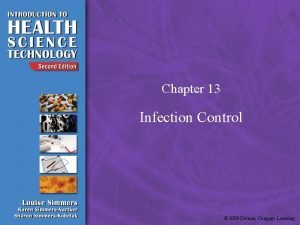Chapter 21 Reproductive System 2009 Delmar Cengage Learning























- Slides: 23

Chapter 21 Reproductive System © 2009 Delmar, Cengage Learning

Objectives • Compare somatic cell division (mitosis) with germ cell division (meiosis) • Explain the process of fertilization • Identify the organs of the female reproductive system and explain their functions • Explain menopause and the changes that occur during this time • Describe the stages and changes that occur during the menstrual cycle • Identify the organs of the male reproductive system and explain their functions • List some common disorders of the reproductive system • Define the key words that relate to this chapter © 2009 Delmar, Cengage Learning

The Reproductive System • http: //www. youtube. com/watch? v=QSN 5 gfbzgwc © 2009 Delmar, Cengage Learning

Functions of the Reproductive System • Accomplish reproduction – Creation of new life • Manufacture hormones – Females – estrogen and progesterone – Males – testosterone • Meiosis – Type of nuclear division in which the number of chromosomes is reduced to one half the number found in a body cell; results in the formation of an egg or sperm • Somatic (body) cells, in humans, contain 46 chromosomes in the nucleus © 2009 Delmar, Cengage Learning

23 Pairs of Chromosomes © 2009 Delmar, Cengage Learning

Female and Male Chromosomes (The 23 rd Pair) © 2009 Delmar, Cengage Learning

Fertilization • Occurs when the sperm nucleus combines with the egg nucleus to form a fertilized egg cell, or Zygote • Fertilization restores the full complement of 46 chromosomes possessed by every human cell, each parent contributing one chromosome to each of the 23 pairs • DNA • All of the inherited traits possessed by the offspring are established at the time of fertilization • The sex chromosomes of the male parent determine the sex of the child but other characteristics are a combination of both parents © 2009 Delmar, Cengage Learning

Female Reproductive System • • • Ovaries Fallopian tubes Uterus Vagina External female genitalia • Breasts © 2009 Delmar, Cengage Learning

External Female Genitalia © 2009 Delmar, Cengage Learning

Menstrual Cycle • • Follicle stage Ovulation stage Corpus luteum stage or luteal phase Menstruation stage © 2009 Delmar, Cengage Learning

Menopause • When monthly menstrual cycle comes to an end • Commonly occurs between 45 and 55 years of age • End of childbearing • Anatomical changes © 2009 Delmar, Cengage Learning

Male Reproductive System • • Testes and epididymis Ductus deferens, seminal vesicles, and ejaculatory ducts Penis Prostate gland Bulbourethral glands Semen Erection and ejaculation Impotence/erectile dysfunction © 2009 Delmar, Cengage Learning

Male Reproductive System © 2009 Delmar, Cengage Learning

Contraception • Abstinence • Reasons for avoiding pregnancy • Methods of contraception © 2009 Delmar, Cengage Learning

Infertility • When conception does not occur after trying for one year • Fertility drugs • Infertility treatments – – In vitro fertilization (IVF) Gamete intrafallopian transfer (GIFT) Zygote intrafallopian transfer Donor eggs and embryos © 2009 Delmar, Cengage Learning

Effects of Aging – Female • Menopause • Declined estrogen and progesterone production • Narrowing of vaginal opening, loss of tissue elasticity, and a decrease in vaginal secretions • Atrophic changes © 2009 Delmar, Cengage Learning

Effects of Aging – Male • Sexual response is slower • Obtaining and maintaining an erection becomes more difficult • Prostate gland size increases, testes decrease in size and sperm level decreases • Testosterone level decreases • Viscosity of seminal fluid diminishes © 2009 Delmar, Cengage Learning

Disorders – Female Reproductive System • Amenorrhea • Premenstrual syndrome (PMS) • Dysmenorrhea • Menorrhagia • Endometriosis © 2009 Delmar, Cengage Learning • • • Fibroid tumors Breast tumors Endometrial cancers Ovarian cancer Cervical cancer

Infections – Female Reproductive System • • Pelvic inflammatory disease (PID) Salpingitis Toxic shock syndrome Vaginal yeast infections © 2009 Delmar, Cengage Learning

Disorders – Male Reproductive System • • • Epididymitis Orchitis Prostatitis Benign prostatic hypertrophy (BPH) Prostate cancer © 2009 Delmar, Cengage Learning

Sexually Transmitted Disease (STDs) • Also known as venereal disease – – – Chlamydia Genital warts or human papillomavirus (HPV) Gonorrhea Genital herpes Syphilis Trichomoniasis vaginalis © 2009 Delmar, Cengage Learning

Human Growth and Development • http: //education-portal. com/academy/lesson/principles-of-growth-and-development. html#lesson © 2009 Delmar, Cengage Learning

Human Growth and Development • • Infancy Toddler Preschool School-age Adolescence Early adulthood Middle adulthood Older adulthood © 2009 Delmar, Cengage Learning
 Chapter 6:2 interpreting word parts
Chapter 6:2 interpreting word parts 2009 delmar cengage learning
2009 delmar cengage learning Introduction to medical terminology chapter 1 answer key
Introduction to medical terminology chapter 1 answer key 2009 delmar cengage learning
2009 delmar cengage learning 2009 delmar cengage learning
2009 delmar cengage learning Chapter 13 medical math assignment sheet
Chapter 13 medical math assignment sheet 2009 delmar cengage learning
2009 delmar cengage learning Delmar cengage learning instructor resources
Delmar cengage learning instructor resources Thomson delmar learning
Thomson delmar learning The human respiratory system chapter 7 handout
The human respiratory system chapter 7 handout Medical terminology chapter 5 learning exercises answers
Medical terminology chapter 5 learning exercises answers Cengage learning heart diagram
Cengage learning heart diagram South-western cengage learning
South-western cengage learning Cengage learning heart diagram
Cengage learning heart diagram Cengage learning australia
Cengage learning australia Cengage learning
Cengage learning Cengage learning
Cengage learning Wadsworth cengage learning
Wadsworth cengage learning Cengage learning
Cengage learning Cengage learning plant cell
Cengage learning plant cell Cengage learning
Cengage learning Cengage learning
Cengage learning Brooks cole cengage learning
Brooks cole cengage learning 2014 cengage learning accounting answers
2014 cengage learning accounting answers








